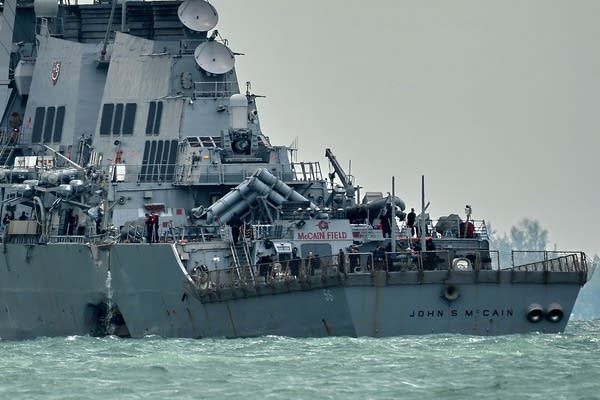On some ships, the Navy is bringing back physical throttles instead of touch-screen controls.

The USS Fitzgerald collided with a Phillipine container ship in June 2017, killing seven sailors. Then, just two months later, the USS John S. McCain collided with a Liberian merchant vessel, killing 10 sailors.
Megan Eckstein, deputy editor for USNI News, part of the U.S. Naval Institute, told me the National Transportation Safety Board found the USS McCain collision was caused by a helmsman who was confused by his touch-screen displays. He meant to slow the ship down, but instead made a sharp right turn.
An investigation led to more than 100 recommendations to improve safety and readiness on ships. Turns out, the touch screen controls for speed are not preferred by a lot of personnel. They want physical throttles instead. The Navy has taken note for new ships and will roll out a retrofit to change existing ones. Meanwhile, Eckstein said it’s not just the control screens but also deficiencies in training that have caused confusion. The following is an edited transcript of our conversation.

Megan Eckstein: I think one of the challenges is simply that there’s not a lot of commonality from ship to ship in the way everything is currently allocated to the fleet. If you’re a sailor and you’re on one ship, you serve there for two or three years. When you go to your next assignment, it might not have the same bridge controls. You might be moving from a physical throttle to a touch screen, or you might be moving from touch screen to touch screen, but they’re not the same, and all the same controls aren’t where you thought they were. In an emergency, everything is muscle memory. And if you’re not sufficiently trained, and the buttons aren’t where you think they are, and it’s not consistent every time you use that system, in an emergency, you’re not going to know how to do it.
Jed Kim: Why and when did the Navy switch to touch-screen throttles?
Eckstein: When the Navy goes through shipbuilding programs and its ship modernization programs, it really doesn’t specify a lot of detailed requirements for the shipbuilders. In a lot of cases, you have shipbuilding companies who, when they’re making their pitches to the Navy, they want the most up-to-date technology, they want the latest and the greatest that they can provide the sailors. In a lot of cases, that has involved moving to more digital systems, more touch-screen systems. So this really isn’t anything the Navy intentionally went toward. It’s something that was driven by industry and this desire to innovate and incorporate the latest and greatest technology.
Kim: What are they doing with the touch screens now?
Eckstein: There’s a lot of ways that the touch screens can be useful. For example, there are certain ships with smaller crews where it’s quite useful to have so much control at your fingertips on a touch screen. I don’t think the Navy fully wants to pull away from those. Also, with the combat systems, having a fully digitized system means that you can update it faster. You can blast out software updates over satellite, even if you have a ship that’s deployed. There are some cases where having touch screens are useful. You must do that with a purpose, and I think the Navy found that physical controls versus touch-screen controls, there wasn’t much of a purpose beyond the technology was there. One of the admirals told me, “This falls in the bucket of we did it because we could,” and I think that’s becoming clear that that’s not a good enough reason to have touch-screen ship controls.
Eckstein said about 60 destroyers will return to the physical throttles, hopefully starting next summer.
She recently interviewed retiring Navy Adm. John Richardson. He had a lot to say about how technological advances played out during his tenure. Essentially, the Navy he left behind is very different from the one he inherited. Something I learned from reading it is that 355 ships is the minimum fleet size believed necessary for achieving the Pentagon’s strategic guidance. Any guesses how many they’d really like? Six hundred fifty-three. Now you’re ready for “Jeopardy!”
An article in Forbes looks at two different Navy ships that are incorporating ambitious new technologies in their designs. One, the author said, is likely headed for a lot of criticism because it’s been touted as battle-ready when it launches. The other is given more leeway on performance because military officials and lawmakers have been told it’s more experimental — something to learn from and incorporate into future ships. Maybe a lesson there on the importance of managing expectations.